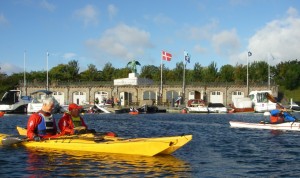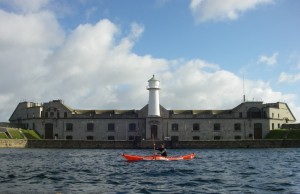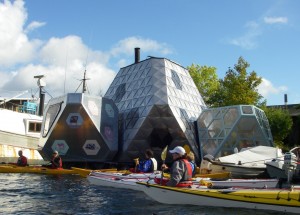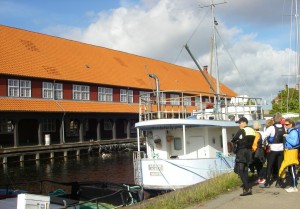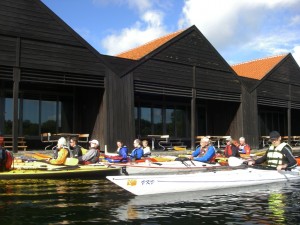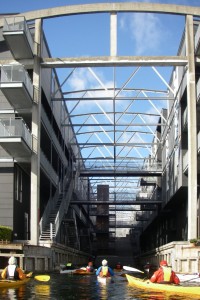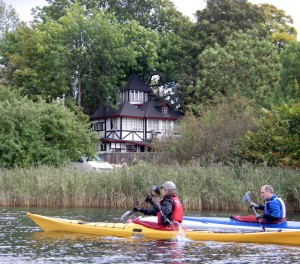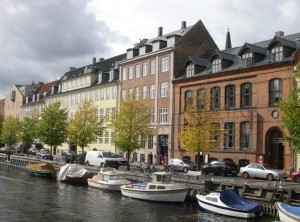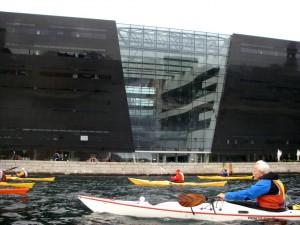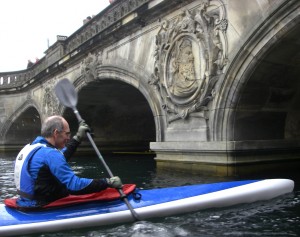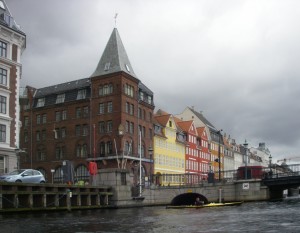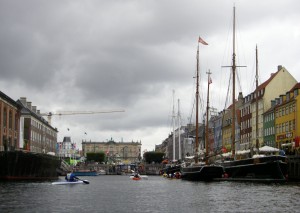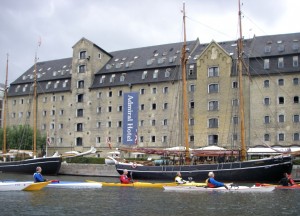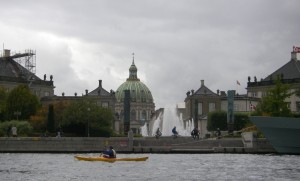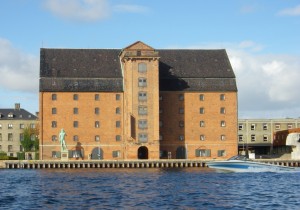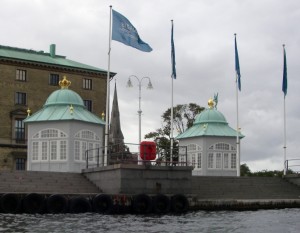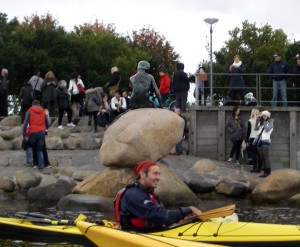The Vedbæk kayak club set off from Langelinie yacht harbour in a brisk east wind.
The numerous wind turbines were spinning well as we headed for Trekroner – a key player in the 1801 battle with Nelson’s fleet.
After this choppy warm up we headed south along the meandering route shown below, with points of interest marked.
Our first shore stop was at the northern end of the arc of bastions which form the seaward defence of Copenhagen. The picture shows one of the more eccentric of the numerous houseboats which line the now peaceful harbour.
We inspected also the ‘Spanteloft’, a long building where the wooden spars were stored over the winter. They were still there during the battle of Copenhagen which was early in the year, so the Danish defence consisted of anchored ships without masts, and cannon boats driven by oars. Even so, the battle was close.
We backed out of the little inlet and made a long detour around the naval reserved area, then entered the moat which formed the second line of defence. We cruised past the sheds once used to house the cannon boats, now home to small enterprises – typically architects and IT consultants.
A little further south is the ‘Torpedo Hall’, used until the 1950s to build motor torpedo boats; now rebuilt as expensive apartments.
We continued down a now blind branch of the defence canal which now reaches the edge of the Christiania enclave, once a military area but now home to highly individual homes and people, though this house seems to be of earlier date.
Doubling back we sneaked out into the main harbour channel past the Opera.
A short paddle south brought us to the entrance of the mercantile part of Copenhagen known as Christianshavn, a peaceful canal sheltered by the double row of fortifications to the east and lined with the houses built by prosperous merchants.
Here we dragged the boats onto a narrow ledge and ate lunch.
We followed the canal out to the main harbour channel and crossed to the other side, passing the ‘Black Diamond’, the extension to the Royal Library designed by Schmidt, Hammer and Lassen and I think the first, and best, example of the outward leaning wall meme which has been disastrously copied by inferior architects building company headquarters all the way down the harbour. In the foreground is our tour leader, Claes Rechnitzer, who has entertained us with lectures on the history of the harbour, with a success varying with the wind speed and the coherence of the group.
Then into the canal which surrounds Slotsholmen, the Danish seat of government. The baroque marble bridge was the ceremonial entrance to Christiansborg palace, most of which burned down in 1884.
On the northern stretch of the canal is the 17th c. Holmens church.
The canal rejoins the main harbour channel which we now followed northward. Dipping into the standard tourist attraction Nyhavn (new harbour, from the 17th c.)). A striking building from the late nineteenth century is the Bethel hotel, the seamen’s home, until very recently a charming temperance hotel with registration in a real paper log book. Recently it has modernised, but still retains a pleasantly old fashioned style, in contrast to the bustling tourist traps across the water.
Nyhavn is a tricky place to maneuver, because of the harbour tourist boats which also have to reverse at the blind end of the harbour. At the exit we have another chance to exercise close navigation skills as we slalom through the tilted pillars which don’t really support the national theatre ( there are sturdy upright pillars to do that).
Further north we make a short detour to view one of the most imposing 18th c. warehouses which line the northern part of the harbour. This is now the Admiral Hotel.
We next pass the royal palace, Amalienborg. This consists of four identical buildings surrounding a majestic open space with a fine bronze horseman in the middle. From the water we can only glimpse the full grandeur of the concept, due to the 18th c. architect Nicolai Eigtved. His domed Marble Church completes this fine urban landscape.
Continuing north we pass the collection of plaster casts of ancient art, housed in a the ‘West Indian’ warehouse, marked by a copy of Michelangelo’s David.
The light is fading and the sky overcast as we pass the charming pavilions at the end of Esplanaden. Kayak paddlers are used to keeping a close watch for weather indicators so the single extended flag flanked by sullenly drooping companions is disturbing.
No tour of Copenhagen, by land or sea, is complete without a visit to the little mermaid. She turns her back to the marine visitor, to charm the permanent flock of tourists on shore.
Tim Padfield
